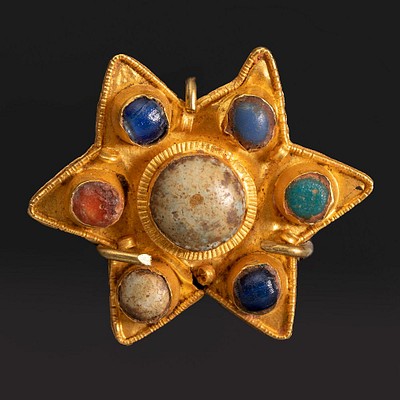Andalusian School; second half of the seventeenth century. "Purisima". Carved wood, gilded and polychrome.
Lot 52
About Seller
Setdart Auction House
Carrer Aragó 346
Barcelona
Spain
Setdart Subastas was born in 2004 and is currently the first online art auction in Spain with solidity, prestige and reliability guaranteed by our more than 60,000 users. Setdart has a young, dynamic and enterprising team ready to successfully manage the purchase and sale of art works through custom...Read more
Estimate:
EUR€2,500 - EUR€3,000
$2,688.17 - $3,225.81
Absentee vs Live bid
Two ways to bid:
- Leave a max absentee bid and the platform will bid on your behalf up to your maximum bid during the live auction.
- Bid live during the auction and your bids will be submitted real-time to the auctioneer.
Bid Increments
| Price | Bid Increment |
|---|---|
| EUR€0 | EUR€10 |
| EUR€200 | EUR€25 |
| EUR€500 | EUR€50 |
| EUR€1,000 | EUR€100 |
| EUR€3,000 | EUR€200 |
| EUR€5,000 | EUR€500 |
| EUR€10,000 | EUR€1,000 |
| EUR€20,000 | EUR€2,000 |
| EUR€50,000 | EUR€5,000 |
About Auction
By Setdart Auction House
Dec 21, 2021
Set Reminder
2021-12-21 07:30:00
2021-12-21 07:30:00
America/New_York
Bidsquare
Bidsquare : Córdoba: 2,000 Years of Art
https://www.bidsquare.com/auctions/setdart-auction-house/c-rdoba-2-000-years-of-art-8049
Setdart Auction House sofia@setdart.com
Setdart Auction House sofia@setdart.com
- Lot Description
Andalusian School; second half of the seventeenth century. "Purisima". Carved wood, gilded and polychrome. Presents silver crown. It has a later base (XX century). Measurements: 59 x 27 x 25 cm (frame). On a golden pedestal stands the promontory of clouds on which the Virgin is supported, this has several little angels that carry different attributes related to the Virgin. The piece stands out for the elegance and magnificence of the Virgin, crowned in silver and dressed in a golden tunic, on which stands out the stewed mantle. Medieval Christianity passionately debated the belief that Mary had been conceived without stain of original sin. Some universities and corporations swore to defend this privilege of the Mother of God, several centuries before the First Vatican Council defined the dogma of faith in 1854. At the end of the Middle Ages the need to give iconographic form to this idea was born, and the model of the Apocalyptic Woman of St. John was taken, maintaining some elements and modifying others (the Apocalyptic Woman is pregnant, but not the Immaculate). The definitive image came to fruition in the 16th century. Following a Valencian tradition, the Jesuit Father Alberro had a vision of the Immaculate Conception and described it to the painter Juan de Juanes so that he could capture it as faithfully as possible. Given the importance given to religious images in the Hispanic world, during the 17th and 18th centuries ambitious pictorial series and extensive iconographic programs were created for churches and convents, as well as printed prints, medals and reliquaries for private devotion. As a whole, regardless of their size or support, these images fulfilled the objective of sacralizing daily life beyond the altars. The Granada school stood out during this period, receiving and developing the stylistic patterns of the Baroque. It is evident the leading role played by the Andalusian school of sculpture during the period that has been called the Golden Age; to it belong a series of masters of unquestionable value who knew how to combine in their works the extraordinary technical quality and religious depth, in accordance with the atmosphere of their time, fully connected with the tastes of the clientele, more interested in the work of religious themes than in the commissions of profane character, thus marking a substantial difference with respect to the production of other European countries. It is also worth mentioning that the economic development and the strength that Seville experienced after the Discovery of America, having become the gateway and port of the Indies, was quickly reflected in art; from the first decades of the century, masters of different origins began to visit the city constantly in search of the American market and the potential Sevillian clientele, increasingly attracted by the new artistic forms arriving from Italy.
- Shipping Info
-
In-house shipping available. Please inquire at admin@setdart.com.
-
- Buyer's Premium



 EUR
EUR CAD
CAD AUD
AUD GBP
GBP MXN
MXN HKD
HKD CNY
CNY MYR
MYR SEK
SEK SGD
SGD CHF
CHF THB
THB

















